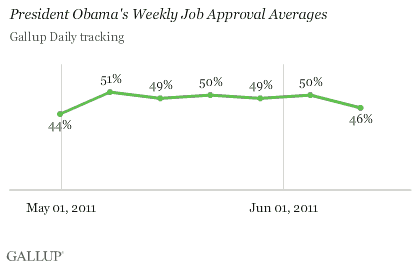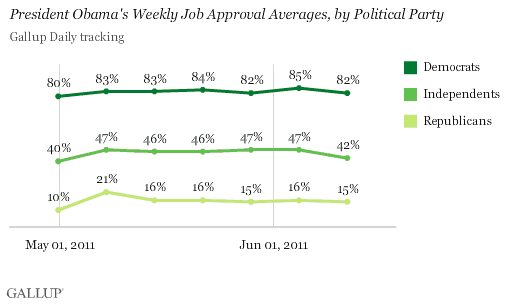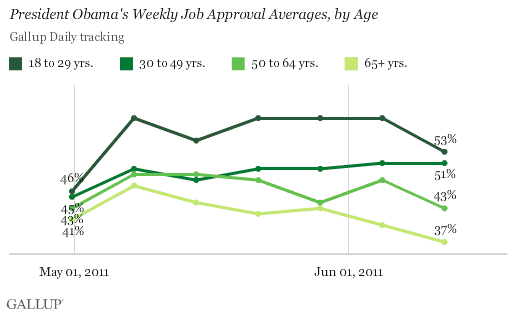PRINCETON, NJ -- President Obama's job approval rating averaged 46% for the week ending June 12, a significant decline from his weekly averages for most of May and nearly back to the level before Osama bin Laden's death on May 1.

Thus, it appears the sustained rally in support for the president after the death of the Sept. 11 terror mastermind is largely over. The drop in Obama's approval rating coincides with an increase in Americans' pessimism about the economy. Economic confidence also increased after bin Laden's death but began to decline early this month, perhaps due to reports of anemic job growth and concerns about the slow pace of economic recovery.
Gallup polling in mid-May found that the rally in support for Obama extended to his approval ratings for handling terrorism and foreign affairs but not his economic approval ratings.
Independents' Ratings Down Most
Among partisan groups, independents' approval rating of Obama dropped the most in the past week, from 47% to 42%, with a smaller decline among Democrats. Republicans' approval of Obama spiked to 21% during the first week after bin Laden's death from 10% in late April, before falling back to the 15% range, where it has held since.

Even though Obama's approval rally is largely over, some subgroups do give the president slightly higher ratings now than immediately before bin Laden's death. Republicans are one such group. Two others are Americans younger than 30 (46% then versus 53% now) and aged 30 to 49 (45% versus 51%). In contrast, senior citizens' approval rating of Obama, now at 37%, is lower than it was before the recent rally began.

Implications
Obama's approval rating has averaged below the majority level for most of the time since early 2010. The 50% approval mark is important because presidents with approval ratings above that level have always won re-election. Obama's approval rating generally held around the 50% mark in May, but that period of higher support seems over now.
There is still much time left for Obama to recover, with Election Day 17 months away. Indeed, at comparable points in their presidencies, Richard Nixon (48%), Ronald Reagan (45%), and Bill Clinton (47%) -- all of whom were re-elected -- had approval ratings similar to Obama's current 46%.
Survey Methods
Results are based on telephone interviews conducted as part of Gallup Daily tracking June 6-12, 2011, with a random sample of 3,552 adults, aged 18 and older, living in all 50 U.S. states and the District of Columbia.
For results based on the total sample of national adults, one can say with 95% confidence that the maximum margin of sampling error is ±2 percentage points.
Interviews are conducted with respondents on landline telephones and cellular phones, with interviews conducted in Spanish for respondents who are primarily Spanish-speaking. Each sample includes a minimum quota of 400 cell phone respondents and 600 landline respondents per 1,000 national adults, with additional minimum quotas among landline respondents for gender within region. Landline telephone numbers are chosen at random among listed telephone numbers. Cell phone numbers are selected using random-digit-dial methods. Landline respondents are chosen at random within each household on the basis of which member had the most recent birthday.
Samples are weighted by gender, age, race, Hispanic ethnicity, education, region, adults in the household, and phone status (cell phone only/landline only/both, cell phone mostly, and having an unlisted landline number). Demographic weighting targets are based on the March 2010 Current Population Survey figures for the aged 18 and older non-institutionalized population living in U.S. telephone households. All reported margins of sampling error include the computed design effects for weighting and sample design.
In addition to sampling error, question wording and practical difficulties in conducting surveys can introduce error or bias into the findings of public opinion polls.
For more details on Gallup's polling methodology, visit www.gallup.com.
